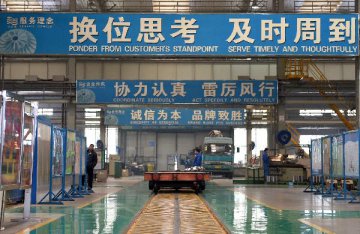
The import and export data released by General Administration of Customs of PRC on Oct. 13 shows that China’s total import and export value records 17.87 trillion yuan in the first three quarters of this year, down by 7.9 percent year on year, with a decline of 1.8 percent and 15.1 percent in export and import respectively, which is far away from the foreign trade growth target of 6 percent set for China at the beginning of this year.
It reflects the reality that China’s export-oriented economic development has entered into a stage of major adjustment. Roadmaps for new round of openness gradually become clear for the central and local governments, with forth effort in creating new advantages of international competition. Service industry will be further opened, with ‘go out’ in 2.0 era. All these will be the highlights in overall arrangements for opening economy in the ‘13th 5-year plan’ period.
Trend: major adjustment for export-oriented economic development
China’s total scale of trade in goods in 2013 exceeded that of America, making it the No.1 worldwide. And China’s foreign investment also surpassed 100 billion US dollars for the first time in 2013. China absorbed the foreign capital more than that of America in 2014, also making it the No.1 worldwide.
However, China’s foreign trade growth rate has greatly dropped back since the second year of the ‘12th 5-year plan’ period, entering into a new growth track of under ten percent.
Song Hong, director assistant of Institute of World Economics and Politics Chinese Academy of Social Sciences, believed that structural adjustment for foreign trade will focus on two aspects: 1) export-oriented development pattern based on cheap production factors, especially the cheap labor force, cannot last, with major adjustment beginning to be carried out, for example, low-end labor intensive industries are gradually transferred outside, with the whole industrial adjustment towards self-owned brands, marketing network and technologies; 2) China is stepping into a stage of self-dependent innovation, instead of bringing in or imitating the technologies.
Some industries suffer a surplus capacity in China after the reform and opening-up for over 30 years. Foreign trade dependence related to resource and energy constantly increases. The ‘three-plus-one’ processing trade pattern (custom manufacturing with materials, designs or samples supplied and compensation trade) relying on price and resource wars is no longer suitable for China’s social and economic development. Mutual development of high-class ‘bring in’ and large scale of ‘go out’ arouses deep integration between the market and resources, with a new situation of interactive development jointly initiated by foreign trade, overseas capital and ‘go out’.
Meanwhile, as a significant arrangement for China’s opening-up strategy in a new era, ‘One Belt and One Road’ strategy is carrying out cooperation with international capacity, which steps into a pragmatic cooperation stage from a stage of top-level strategic conception. After the establishment of Shanghai Free Trade Zone (FTZ) for over one year, China has added three pilot FTZs in Guangdong Province, Tianjin City and Fujian Province since latter April, and expanded Shanghai FTZ.
Transformation: new pattern formed for international commerce
In terms of international factors, global economy will gradually return to a stable growth period during the ‘13th 5-year plan’, with accelerated regional economic integration. International division of labor enters a new stage of adjustment, with expanded influence from new rules of international trade and investment.
In terms of national factors, the economy constantly faces downtrend pressure. New system is forming for the open economy, with positive changes in market environment. China faces challenges from opening-up and new rules. In addition, low-end labor intensive industries will be transferred to outside market soon, with increasing transition pressure at the end of the ‘13th 5-year plan’ period.
Along with the advancement of international industry transfer, a new round of outbound investment will boom. Xing Houyuan, deputy director of the Chinese Academy of International Trade and Economic Cooperation under the Ministry of Commerce, believes that the new round of outward investment is ‘go out 2.0 era’. The process, which conforms to the trend of international cooperation and the strategy of ‘One Belt and One Road’, is formulated in response to the demand of global market and the stage of China’s own economic development, having strategic significances on building cross border industrial system.
However, China remains at the middle of value chain in the global industrial division, engaging in international division with lower levels, lower R&D and innovation requirements and fewer added values. After stepping into medium and high income or postindustrial society, value chain division plays an important role. The level of value chain division of a nation even determines its competitiveness. Therefore, China should take part in higher-level international division and competition, climbing to medium and high income value chain represented by higher ends of the smiling curve.
Policy: strategic deployment of further Opening
In Sept., Opinions on Build New System of Open Economy was issued. The Opinions carried out top-level design for the new round of high standard opening up, and put forward to create new ways for foreign investment management, build new mechanism serving the ‘going-out’ strategy, design new approach for the sustainable development of foreign trade and accelerate the implementation of ‘One Belt and One Road’ strategy.
Policies in respect of further opening-up on local level also have been issued one after another recently. For example, Shanxi Province issued Opinions on Comprehensive Opening Up, which proposes to transform resource-based economy of the province through the key cut-in points of comprehensive opening up and developing opening-oriented economy. Shanxi Province is also planning to substantially implement ‘One Belt and One Road’ and take measures to support enterprises to invest overseas. Ningxia Autonomous Region published Opinions on Implementation of ‘One Belt and One Road ’and Speeding up the Opening Up of Ningxia, which put forward to actively implement ‘One Belt and One Road’, accelerate opening up strategy, and strive to establish new opening economy system in inland area. Local governments of Guangzhou, Xiamen and Dalian have also introduced similar policies.
Particularly, to implement ‘One Belt and One Road’ and to vigorously support enterprises to invest abroad are hot spots in local documents. The Opinion also expressly prescribed that the establishment and implementation of ‘going out’ is a national policy in the new period, which aimed to facilitate outbound investment, create new ways for outbound investment and combine ‘bringing in’ and ‘going out’. Opening up in service industry will also be highlighted in the further opening up in 13th five-year period.
“China should speed up the implementation of strategies related to high standard free trade zone, replicate and promote opening measures tested in Shanghai Free Trade Zone to a wider area, and actively cut tariff and clean out non-tariff barrier. And at the same time, creatively open more service trade market”, said Huo Jianguo.
Translated by Adam Zhang and Jelly Yi























Latest comments